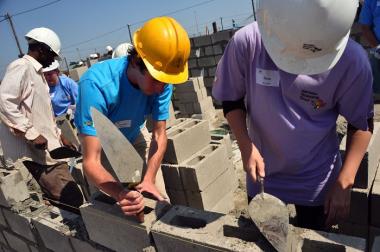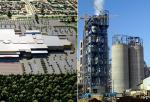Building material companies thriving despite the odds
 There is a price war in the cement industry but the aggregates market is extremely strong, says CEO Andries van Heerden.
There is a price war in the cement industry but the aggregates market is extremely strong, says CEO Andries van Heerden.
While other building material and industrial mineral companies have struggled to live up the hype, Afrimat and Corobrik on the other hand have been thriving despite a weak economy.
Diversified aggregates, concrete products, and industrial minerals group Afrimat is keeping its head above water at a time when volatility is a byword for the country’s building and construction industries. SA’s economy is “flat on its back”, says CEO Andries van Heerden.
The company has lost a significant customer in the now defunct Evraz Highveld Steel and Vanadium, SA’s second largest steel producer, to which it sold mined materials.
Despite this loss, and despite a “dogfight going on” in the domestic cement industry — a major Afrimat customer — the company posted decent results for the year to end-February, with headline earnings per share jumping 15.5%.
“There is a price war in the cement industry. (But) the aggregates market is extremely strong,” Van Heerden says.
Aside from cheap Asian cement imports, there is substantial overcapacity in regional cement markets, spurred by newcomers Sephaku Cement and Mamba Cement — backed, respectively, by Nigerian and Chinese interests.
However, state-funded rural infrastructure projects, including roads, water, sanitation, clinics, and schools, are boosting business. Van Heerden says momentum in smaller infrastructure projects is growing, as Department of Human Settlements and South African National Roads Agency grants have risen considerably.
This has been bolstered by cash-in-hand sales of blocks and bricks in rural areas, even as SA’s mainstream construction, steel, and mining industries struggle to stay afloat.
“The nice thing is that our business model is extremely entrepreneurial and constantly on the lookout for opportunities,” Van Heerden says.
He says some building and construction-related companies have teamed up with black entrepreneurs in a “new business model that works exceptionally well”.
“But the bottom line is the economy is flat on its back,” he says. Afrimat is anticipating a slowdown in building and construction markets and is positioning itself for this.
Another building materials company that is thriving, despite the odds, is Corobrik. The unlisted Durban-based brick and concrete block maker has 17 factories and 28 sales centres nationally. It also has 32 quarries across SA and distributes products wholesale and through retailers such as Builders Warehouse.
Corobrik MD Dirk Meyer says that while there is little large-scale infrastructure being built in SA, the company is “fortunate in that our product can go into any building”.
Meyer says Corobrik invested R700m in 2007, just as the National Credit Act kicked in and SA’s housing market started to slide precipitously off a multi year peak. He says this provided cost advantages and market share to the company.
The company focused on affordable and low-cost housing, and thermally efficient clay brick technology that was suited to state-subsidised homes.
The black-empowered company has 3,000 employees, and says it can do the full spectrum of private and public sector building work, including jails, courts, and police stations.
Corobrik has a turnover of R3bn, selling 1-billion brick products a year, or enough to build 150 assorted structures a day, Meyer says. These include facebrick and paving products suitable for interiors and exteriors, and for mixing with glass, concrete and wood structures.
“We are working on influencing architectural trends, Meyer says. To this end, the company holds the Corobrik Architectural Student of the Year Awards, held annually for the past 28 years. First prize was R50,000 in 2016.
“Because the building industry is not growing substantially, it is all about taking market share and product innovation,” Meyer says. This includes adding glazings and colourings to brick products.
About 90% of Corobrik’s business is in SA, where there is lots of “room for growth”.
The company also exports to Southern African Development Community countries and to Australia. It once exported to Singapore and Japan, but those markets have slowed to a trickle, Meyer says.
Some building materials firms, such as AG Industries, a maker and wholesaler of glass and aluminium products that listed in 1990, were killed off after global markets collapsed in late 2008. African Brick, which listed on AltX in late 2007, sank four years later.
Others, such as steel fabricator and distributor Alert Steel, which listed in 2007, are still in liquidation. WG Wearne, one of SA’s oldest suppliers of materials to the building and construction industries, established in 1910, has been unable to recover. Its share price has plummeted from more than R6 in 2007 to about 9c now.
Brikor, a manufacturer of clay bricks, roof tiles and clay pipes, has been in trouble almost since listing on AltX in May 2007. It once had annual output of more than 270-million bricks, 5,400 tonnes of clay pipes, 40-million roof tiles, and 70-million pavers.
The company came out of an agonising provisional liquidation process in late 2015, saying it was the first JSE-listed company to do so. Its share price fell from R1.80 to 9c when it was suspended in mid-2013.
But not all building and construction materials companies have such sad tales. Corobrik’s Meyer says his company has become dominant since the effective demise of Brikor.
Afrimat and Calgro M3, which listed only a few years before the October 2008 rout on global markets, have thrived since then. Both have risen from about R2 a share in early 2009 to about R22 now.

















